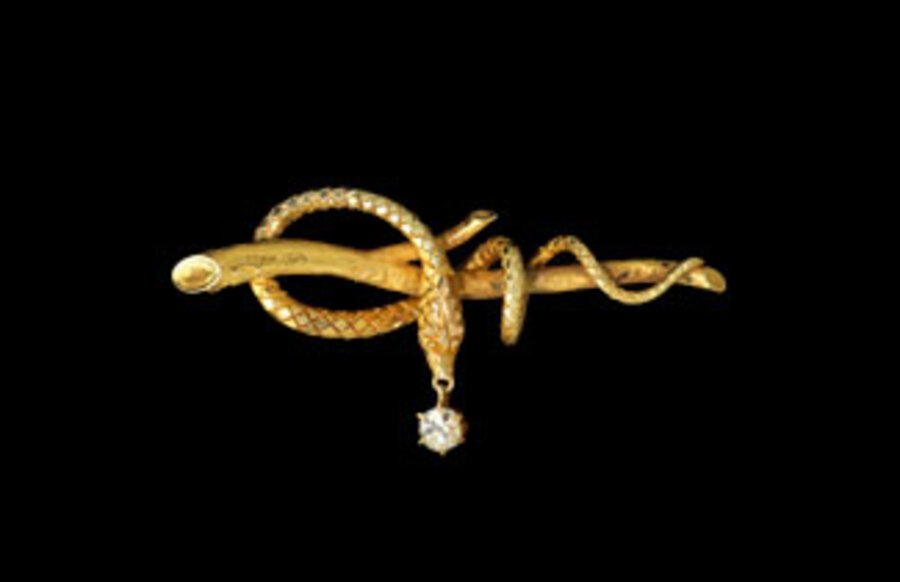Madeleine Albright: Read My Pins
Loading...
| New York
Most people's jewelry just says "bling." Not former Secretary of State Madeleine Albright's gems. For a meeting with Yasser Arafat, the message of Ms. Albright's brooch – a two-inch-long gold bee with diamond-studded wings and garnet eyes – was "sting."
"I spent many hours wrangling with the Palestinian leader about the need for compromise in the Middle East," she writes in her book, "Read My Pins: Stories From a Diplomat's Jewel Box" (HarperCollins, 2009). "My pin reflected my mood."
More than 200 pins are displayed at the Museum of Arts and Design in New York through Jan. 31 in an exhibition titled "Read My Pins: The Madeleine Albright Collection." The show will travel through 2010 to the William J. Clinton Presidential Library in Little Rock, Ark., as well as to venues in Washington, D.C., and Indianapolis, Ind.
In introducing her collection, Ms. Albright, reminisced about the origin of her strategically deployed ornaments. "I clearly have always liked jewelry, but it had not occurred to me that they could, in fact, become part of diplomacy. It all began with Saddam Hussein."
As ambassador to the United Nations in 1994, she pressed Mr. Hussein to allow weapons inspections, causing an Iraqi newspaper to label her "an unparalleled serpent." After a meeting on Iraq, "a gaggle of journalists" saw Ms. Albright sporting a menacing gold snake pin. When asked why, she answered, "because Saddam Hussein called me a serpent."
After that, whenever journalists or colleagues asked her mood or what was on her agenda, she modified President George H.W. Bush's "Read my lips" quip into "Read my pins." "If we were going to do happy things or something pleasant, I'd wear flowers and butterflies and balloons," she says. "On bad days I wore various bugs and weapons. It obviously became a signaling process."
Albright says she's pleased her collection is characterized by museum curator David McFadden as " 'small-d' democratic." Although it includes some antiques and costly materials, most of the pieces are costume jewelry, chosen for their symbolism.
For a 1999 summit with the Russians, the secretary wore a pin of the three wise monkeys with their hands clapped over eyes, ears, and mouth in classic poses to telegraph see, hear, and speak no evil. Albright explains: "I wore those because I disagreed with what they were doing in Chechnya. They would not admit to any human rights abuses."
Much more than trinkets, the pins – her personal diplomatic signature – "really have served a very important foreign-policy mission," she notes. When discussing an antiballistic missile treaty with Russian foreign minister Igor Ivanov, she wore an arrow-shaped geometric pin. "Is that one of your interceptors?" Ivanov asked. "Yes, we make them very small, so it's time to negotiate!" Albright shot back.
Talk about wearing your heart on your sleeve – or, in this case, your shoulder! No poker face for this diplomat, whose arsenal of jewelry became an effective tool. "The world has had its share of power ties," she writes. "The time seemed right for the mute eloquence of pins with attitude."
As she progressed from ambassador to the UN to first female secretary of State (and highest ranking woman in the history of the US government), Albright's pins grew bolder and more dramatic. She began to combine pins, like an enamel-and-rhinestone American eagle with an Uncle Sam hat perched at a rakish angle. The multiple-pin strategy had a drawback: Her clothes came to resemble dartboards. "I got so many holes in my clothes from wearing all these pins," she says, "I had to buy larger pins to cover the holes."
Some pins were not fun to wear but, like a mood ring, signaled melancholy. When flying to Kenya and Tanzania in 1998 to retrieve victims' bodies from the American Embassy bombings, she wore a gold-plated angel. On the way back with the coffins, she wore a tricolor memorial bow in homage to the lives lost.
In general, her pins were pretty obvious signifiers. A snail or crab showed impatience with the slow pace of negotiations, while an octopus implied complexity. Her turtles suggest the need for tenacity and persistence, while an abstract pin of fused glass shards embodies "the glass ceiling in its ideal condition – shattered."
Her favorite pin has sentimental value – a lumpy ceramic heart her 5-year-old daughter made for her on Valentine's Day. Another emotion-laden pin was given to her in New Orleans by a Katrina survivor. It had been a 50th anniversary present from a World War II veteran to his wife, who died as a result of the hurricane. When the woman's son insisted, "We need you to accept" the diamond-and-amethyst pin, she replied, "It would be an honor." She admits the gift "totally broke me up. It isn't often as secretary of State that I teared up, but that is a very moving pin."
"It symbolizes the message that jewelry can send," she adds. "It isn't just things that dazzle the eye but also that recall to the mind the face and spirit of a loved one."
The message Albright hopes the exhibition and book convey is: "Foreign policy is very, very hard, and it doesn't hurt to do something slightly unexpected and have a sense of humor."
"Foreign policy," she says, "shouldn't be so foreign." Her hope is that the stories her pins reveal make statecraft less boring and more understandable.
"The whole purpose," according to Albright, "is to teach."
An American flag lapel pin has become the go-to accessory for politicians. But Albright's enamel ladybugs, moonstone dandelion puff, and gilded brass sunburst teach the value of variety. E pluribus unum doesn't mean speaking with one voice on adornment. While never forgetting the gravity of her job, as her gilt-metal Atlas pin carrying the weight of the world on his shoulders shows, she injected levity, humanity, and beauty into the task of representing the USA.






